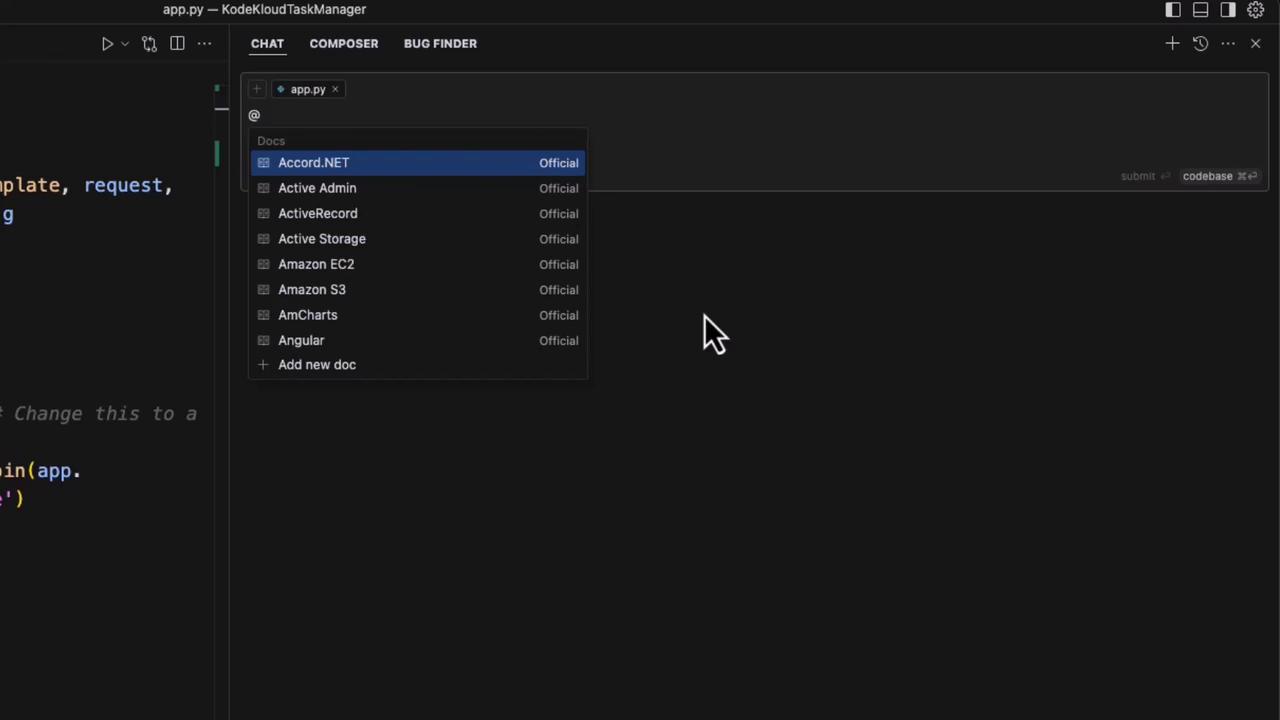Cursor AI
Interacting with your Codebase
Demo Web and Library Integration
In this tutorial, we’ll show how to supercharge your IDE with Cursor AI’s in-editor web search and local documentation features. By embedding search and docs directly in your coding environment, you can streamline development, boost productivity, and avoid context switching.
Searching the Web Inside the IDE
With Cursor AI, you can submit web queries from your terminal or editor, using your project files as context. For instance, try:
What is the best way to implement JWT authentication in Flask?
Cursor will fetch relevant articles, snippets, and code samples without leaving your IDE. Here’s a complete Flask example illustrating JWT authentication, refresh tokens, and token revocation:
from flask import Flask, jsonify, request
from flask_jwt_extended import (
JWTManager, create_access_token, create_refresh_token,
jwt_required, get_jwt_identity
)
from datetime import timedelta
app = Flask(__name__)
app.config["JWT_SECRET_KEY"] = "your-secret-key" # Use a secure random key in production
app.config["JWT_ACCESS_TOKEN_EXPIRES"] = timedelta(hours=1)
jwt = JWTManager(app)
# In-memory token blacklist
blacklist = set()
@app.route("/login", methods=["POST"])
def login():
username = request.json.get("username")
password = request.json.get("password")
# Replace with real credential validation
if username != "test" or password != "test":
return jsonify({"msg": "Bad username or password"}), 401
access_token = create_access_token(identity=username)
refresh_token = create_refresh_token(identity=username)
return jsonify(access_token=access_token, refresh_token=refresh_token), 200
@app.route("/protected", methods=["GET"])
@jwt_required()
def protected():
current_user = get_jwt_identity()
return jsonify(logged_in_as=current_user), 200
@app.route("/refresh", methods=["POST"])
@jwt_required(refresh=True)
def refresh():
current_user = get_jwt_identity()
new_access_token = create_access_token(identity=current_user)
return jsonify(access_token=new_access_token), 200
@jwt.token_in_blocklist_loader
def check_if_token_revoked(jwt_header, jwt_payload):
jti = jwt_payload["jti"]
return jti in blacklist # Check against your blacklist storage
if __name__ == "__main__":
app.run(debug=True)
Warning
Always store JWT_SECRET_KEY in environment variables or a secure vault in production to protect against token forgery.
Browsing Local Docs Without Leaving Your Editor
Cursor AI embeds your local documentation—Flask, PyTorch, Python, Pytest, and more—into a dedicated sidebar. You can navigate topics or ask questions like “How do you implement meta tags in a Flask application?” and get immediate answers drawn from your project's source docs.

For example, Cursor might generate this base.html meta tag template:
<!DOCTYPE html>
<html lang="en">
<head>
<meta charset="UTF-8">
<meta name="viewport" content="width=device-width, initial-scale=1.0">
<!-- Default meta tags -->
<title>,Default Title,</title>
<meta name="description" content=",Default description for your site,">
<!-- Open Graph / Facebook -->
<meta property="og:type" content=",website,">
<meta property="og:url" content="{{ request.url }}">
<meta property="og:title" content=",Default Title,">
<meta property="og:description" content=",Default description for your site,">
<meta property="og:image" content=",{{ url_for('static', filename='images/default-image.jpg', _external=True) }},">
<!-- Twitter -->
<meta name="twitter:card" content="summary_large_image">
<meta name="twitter:title" content=",Default Title,">
<meta name="twitter:description" content=",Default description for your site,">
<meta name="twitter:image" content=",{{ url_for('static', filename='images/default-image.jpg', _external=True) }},">
,
,
</head>
<body>
,
,
</body>
</html>
,[object Object],[object Object],[object Object],[object Object],[object Object],[object Object],[object Object],[object Object],[object Object],[object Object],[object Object],[object Object]